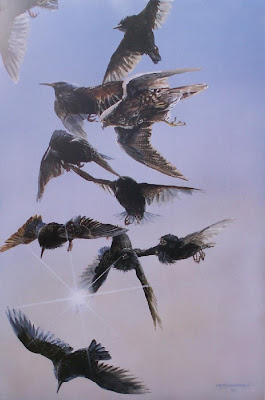MAGICIAN MERLINS

Merlins (Falco columbarius) are powerful little falcons that are found throughout the holarctic region. In North America, their recorded breeding range extends a bit south of the Canada/U.S. Border. Along the Pacific Coast, they nest as far south as Northern California. Only slightly larger than the better-known American Kestrel (F. sparverius), they appear very different from those common falcons in the air. Their wings are broader and their tails shorter. Their flight is much more powerful and direct—in every aspect they are more like a tiny Gyrfalcon. Where the kestrel feeds mostly on rodents and insects, the Merlin's diet consists almost exclusively of birds. Because of this, they're never found in the kind of numbers that kestrels can reach, but by no means are they rare birds. Here in Utah, they are rather common winter visitors, and seem especially fond of agricultural areas. It's not unusual to see them in Salt Lake City, and this past winter, I had one fly within inches of my head as I rode my bicycle down the busiest street in the state.
One old record exists of a Merlin nest in northern Utah, but as far as I know, none have been found here in the past 80 years. I've suspected for a long time that this fact is not representative of the species' true breeding status. In the 1970s, I observed a pair during several summers in the mouth of Parley's Canyon, just east of Salt Lake City, and in recent years, I've seen a pair in the mouth of nearby Red Butte Canyon. Despite all the effort I could muster, I never found these birds' nests, nor did I ever see fledglings, but I believe they probably existed. Unlike most falcon species, Merlins don't have a typical nesting modus operandi. They'll use the abandoned nest of a magpie, hawk or squirrel, a tree cavity, or a cliff niche. There are even numerous records of them nesting on the ground. Add to this fact the hyperactive manner and small size of the species, and the difficulty of discovering a nest site becomes obvious.

For the past couple of days, a Merlin has been hanging around a residential area in Salt Lake City. Normally, migrant Merlins leave the state by mid-February, so this bird has me excited. I spent the better part of yesterday trying to see and photograph her, but my efforts would be best described as “loitering.” I did manage to snap her silhouette twice. Whether I get the chance to photograph her again remains to be seen. A single bird in March is a far cry from a nesting pair in May, but I plan to spend a lot of time in this neighborhood, and expect to be on a first-name basis with every cop on the beat by the end of April. I'd be interested to hear from anyone with Merlin insights to share.
_____________________
upper: WORKING THE FLOCK -- MERLIN & STARLINGS (1990) acrylic 30" x 20"
lower: Bad Merlin photographs taken by CPBvK in Salt Lake City 3-22-'07






8 Comments:
The bird you photographed is a kestrel, asshat!
When I was in training at Depot (the RCMP training acadamy in Regina) we had a pair of Merlin nesting in a large tree just outside our dorm, on the corner of the parade square. Forming up for a noon parade I always found it difficult keeping my "eyes front" as they tended to wander over to the nest.
Boy, your anonymous commenter has better eyes than mine, because I can't make out any field marks in your photo.
Mystery Commenter: Thanks for your insights. I won't try to argue that I'm not an asshat (whatever that is), but I stand by my ID of the Merlin.
Clare: Nice to hear from you. I'd have lasted about 20 minutes as a mountie.
Ah the joys of internet. I can't make an ID from the picture so I'll trust the guy who has seen it, even if that also makes an asshat out of me.
Carel, good luck, and please keep us informed about your adventures on the tail of the Merlin.
Too much times has passed since I stopped by here. I am always rewarded.
Tabor
I guess I'm an asshat too!
That bird is no kestral. I trust you to absolutely know a Merlin, but there's enough in your photos for me from the breast markings to the "big shouldered" profile. Kestrals look "loose" and dainty compared to that compact little rocket. I remember once watching a first year Merlin chasing tree swallows over a lake in Maine. The Merlin didn't seem to be serious as it stooped and climbed and even tail-chased the smaller birds always seeming to "pull its punches".
I join the rest of the asshats in saying that bird doesn't look like a Kestrel. Looks more like Merlin to me. Kestrels are seen quite frequently around our farm. Awhile back, I had to rescue one that had chased sparrows around the local grocery story entrance and became trapped inside a glass portico structure. I haven't seen a Merlin around the farm in awhile. Maybe ten years ago, a Merlin chased a sparrow into one of the windows of our house. The sparrow expired instantly, but the Merlin pulled up and missed a direct impact. While recovering, it perched on a post right outside the window, affording a great view. Unfortunately, that was in my pre-digital camera days.
Post a Comment
<< Home